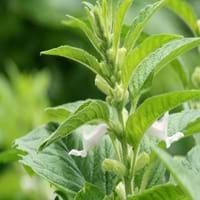Life Span
Perennial
Annual
Origin
Europe, Asia
Africa
Types
-
White Sesame, Black Sesame, Golden Sesame
Habitat
Dry areas, Roadsides, stream banks, Stream side, Waste areas
Cultivated Beds
USDA Hardiness Zone
3-7
9-11
Sunset Zone
1a, 1b, 2a, 2b, 3a, 3b, 4, 5, 6, 7, 8, 9, 10, 11, 12, 13, 14, 15, 16, 17, 18, 19, 20, 21, 22, 23, 24
-
Habit
Clump-Forming
Upright/Erect
Flower Color
White, Lavender
White, Pink, Lavender
Flower Color Modifier
Bicolor
Bicolor
Fruit Color
Sandy Brown
Green, Brown
Leaf Color in Spring
Gray Green, Gray
-
Leaf Color in Summer
Gray Green, Gray
Green
Leaf Color in Fall
Gray Green, Gray
Green
Leaf Color in Winter
Light Green
Light Green
Leaf Shape
Arrowhead
Lanceolate
Plant Season
Spring, Summer, Fall
Summer
Sunlight
Full Sun, Partial Sun
Full Sun, Partial Sun
Growth Rate
Fast
Very Fast
Type of Soil
Clay, Loam, Sand
Loam, Sand
The pH of Soil
Acidic, Neutral, Alkaline
Neutral
Soil Drainage
Well drained
Well drained
Bloom Time
Summer, Late Summer, Early Fall
Indeterminate
Tolerances
Drought, Dry soil
Drought
Where to Plant?
Container, Ground
Ground
How to Plant?
Seedlings
Seedlings
Plant Maintenance
Low
Medium
Watering Requirements
Do Not over Water, Never Over-water, Requires regular watering, Water when soil is dry
Average Water Needs
In Summer
Lots of watering
Lots of watering
In Spring
Moderate
Moderate
In Winter
Average Water
Average Water
Soil pH
Acidic, Neutral, Alkaline
Neutral
Soil Type
Clay, Loam, Sand
Loam, Sand
Soil Drainage Capacity
Well drained
Well drained
Sun Exposure
Full Sun, Partial Sun
Full Sun, Partial Sun
Pruning
Prune if you want to improve plant shape, Prune in spring, Remove damaged leaves, Remove dead leaves
Remove damaged leaves, Remove dead branches, Remove dead leaves
Fertilizers
fertilize every 2-3 weeks while growing, fertilize in growing season
Apply N-P-K
Pests and Diseases
Caterpillars, Leaf Hoppers, Nematodes, Spider mites
Dry root rot, Phyllody, Phytophthora blight, Red blotch
Plant Tolerance
Drought, Frost
Drought
Flower Petal Number
Single
Single
Fragrant Bark/Stem
Yes
Yes
Foliage Texture
Medium
Medium
Foliage Sheen
Matte
Matte
Attracts
Flying insects, Insects, Spider Mites
-
Allergy
Avoid during Pregnancy, Headache, Stomach pain, Vomiting
Abdominal pain, Anaphylaxis, breathing problems, Mouth itching, Nausea
Aesthetic Uses
Beautification, Landscape Designing, Showy Purposes
-
Beauty Benefits
-
Prevents greying of hair, Remove blemishes, Speed hair growth
Environmental Uses
Air purification
Air purification
Medicinal Uses
Arthritis, Cold, constipation, Fever, Insomia, Migraines, Upset stomach
Astringent, Diuretic, Emollient, Nutritive, Tonic
Part of Plant Used
Whole plant
Leaves, Seeds
Other Uses
Air freshner, Decoration Purposes, Employed in herbal medicine, Making Perfumes, Making Shampoo, Making Sweet Scented Oil, Medicinal oil, Used as Ornamental plant, Used for its medicinal properties
Used for making soaps, Used for producing cooking oil, Used in salads
Used As Indoor Plant
Yes
No
Used As Outdoor Plant
Yes
Yes
Garden Design
Container, Herb / Vegetable, Mixed Border
Edible, Herb / Vegetable
Botanical Name
NEPETA cataria
SESAMUM indicum
Common Name
Cat Nip, Catnip
Sesame
In German
Katzenminze
Sesam
In Greek
Είδος δυόσμου
Σουσάμι
In Portuguese
catnip
Sésamo
In Polish
Kocimiętka
Sezam
Phylum
Magnoliophyta
Magnoliophyta
Class
Magnoliopsida
Magnoliopsida
Family
Lamiaceae
Pedaliaceae
Clade
Angiosperms, Asterids, Eudicots
Angiosperms, Asterids, Eudicots
Subfamily
Nepetoideae
Asternae
Properties of Catnip and Sesame
Wondering what are the properties of Catnip and Sesame? We provide you with everything About Catnip and Sesame. Catnip doesn't have thorns and Sesame doesn't have thorns. Also Catnip does not have fragrant flowers. Catnip has allergic reactions like Avoid during Pregnancy, Headache, Stomach pain and Vomiting and Sesame has allergic reactions like Avoid during Pregnancy, Headache, Stomach pain and Vomiting. Compare all the properties and characteristics of these two plants. Find out which of these plant can be used as indoor plant. If you are interested to decorate your house and garden, find out aesthetic uses, compare them and select the plant which will beautify your surrounding. Along with beautification, try comparing medicinal and edible uses of Catnip and Sesame and you can choose the plant having best and most benefits.
Season and Care of Catnip and Sesame
Season and care of Catnip and Sesame is important to know. While considering everything about Catnip and Sesame Care, growing season is an essential factor. Catnip season is Spring, Summer and Fall and Sesame season is Spring, Summer and Fall. The type of soil for Catnip is Clay, Loam, Sand and for Sesame is Loam, Sand while the PH of soil for Catnip is Acidic, Neutral, Alkaline and for Sesame is Neutral.
Catnip and Sesame Physical Information
Catnip and Sesame physical information is very important for comparison. Catnip height is 980.00 cm and width 60.00 cm whereas Sesame height is 30.00 cm and width 25.40 cm. The color specification of Catnip and Sesame are as follows:
Catnip flower color: White and Lavender
Catnip leaf color: Gray Green and Gray
Sesame flower color: White, Pink and Lavender
- Sesame leaf color:
Care of Catnip and Sesame
Care of Catnip and Sesame include pruning, fertilizers, watering etc. Catnip pruning is done Prune if you want to improve plant shape, Prune in spring, Remove damaged leaves and Remove dead leaves and Sesame pruning is done Remove damaged leaves, Remove dead branches and Remove dead leaves. In summer Catnip needs Lots of watering and in winter, it needs Average Water. Whereas, in summer Sesame needs Lots of watering and in winter, it needs Average Water.





